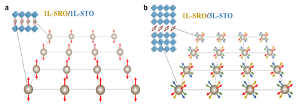Films are originally synthesized to replace bulk monocrystals out of economy and effectiveness concern. Derived from film fabrication, an emerging technology known as interface control creates completely new structures by selecting every atomic or molecular layer. Previous study focuses mainly on molecular multilayer while the mechanism of monolayers remains unclear.Published on Science Advances on April 10th, a paper entitled as Correlation-Driven Eightfold Magnetic Anisotropy in a Two-Dimensional Oxide Monolayer claims to have discovered new MA in a SrRuO3 monolayer and thus the interplay between electron correlation and MA.
Researchers fabricate SrRuO3/(SrTiO3)N (N=1 to 5) superlattices by pulsed laser deposition (PLD) to explore magnetism of a molecular monolayer. The SrRuO3 superlattice is the ideal model by virtue of its strong spin-orbit coupling(SOC), stable long-range magnetic ordering and relatively high Curie temperature. Serial experiments are then conducted to analyse typical properties of SrRuO3/(SrTiO3)N superlattices, among which structure analyses indicate the in-plane and out-of-plane spin of Oxygen octahedron, magnetic tests including magneto-optic Kerr effect(MOKE) and polarized neutron reflectometry(PNR) prove that ferromagnetism only exists in a SrRuO3 monolayer, and magnetic field angle-dependent resistance(MAR) measurements reveal that when N>3, magnetic easy axis of Ru spins is transformed from uniaxial〈001〉direction to eightfold〈111〉directions . This eightfold anisotropy enables unprecedented 71° and 109° spin switching in SrRuO3 monolayers.
First-principle calculations reveal that increasing the SrTiO3 layer thickness (N from 1 to 5) weakens the out-of-plane coupling and induces an emergent correlation-driven orbital ordering. For N>3, the orbital reorientation followed by the opening of energy gap leads to a metal-to-semiconductor transition, which influences spin-orbit interactions within a SrRuO3 monolayer. These two phenomena combined ultimately change MA.

The change of MA in a SrRuO3 monolayer (Image by LU Yalin et al)
The research sheds new lights on the electron correlation system, the forefront of quantum materials. The asymmetry of space inversion and translation in correlated oxide interfaces enables malleability which is not exhibited by their bulk counterpart. As a result, the electron correlation system promises great potential in novel quantum materials. It is not only a crucial platform of fundamental science but only the basis of embryonic electron correlation physics.
Besides, this research also has profound scientific and technological implications for quantum effects. As Jochen Mannhart from Max Planck Institute puts it, exotic quantum effects come into being through the tight correlation of interfaces as well as adjustments of stress or electronic field when you stack quantum materials and put them in the quantum well. At past, the most common research object is molecular multilayer where spin-orbit exchange and coupling exist between layers. When it comes to a monolayer, however, will new quantum states generate from strongly correlated electrons in the magnetic interface without above-mentioned coupling between layers? Given that MA is the prerequisite of long-range magnetic ordering stability in 2D materials, does a magnetic oxide monolayer show different MA from normal 2D materials? Answering these two questions, the research pushes back the frontier of quantum effects in 2D materials.
The research group is led by Prof. LU Yalin from University of Science and Technology of China(USTC), A.P. ZHAI Xiaofang from USTC (currently work for Shanghai Tech University) and A.P.CHEN Hanghui from New York University Shanghai in collaboration with ZHOU Hua from Argonne National Laboratory, GUO Jinghua from Lawrence Berkeley National Laboratory, Padraic Shafer from Lawrence Berkeley National Laboratory, Alexander Grutter from American National Institute of Standards and Technology, XIA Jing from University of California Irvine. The research is funded by National Science Foundation of China and Ministry of Science and Technology of the People's Republic of China. The corresponding authors are A.P. ZHAI Xiaofang and A.P. CHEN Hanghui. The primary author is post-doctor CUI Zhangzhang from USTC.
Paper link: http://advances.sciencemag.org/content/6/15/eaay0114
(Written by LIU Wei, edited by YE Zhenzhen, USTC News Center)